Design and Fabrication of Piezoelectric Micromachined Ultrasound Transducer (pMUT) with Partially-Etched ZnO Film
Abstract
:1. Introduction
2. Finite Element Analysis for a Piezoelectric Composite Diaphragm
3. Microfabrication of pMUT
4. Results and Discussion
5. Conclusions
Acknowledgments
Author Contributions
Conflicts of Interest
References
- Pedersen, T.; Zawada, T.; Hansen, K.; Lou-Moeller, R.; Thomsen, E. Fabrication of High-Frequency pMUT Arrays on Silicon Substrates. IEEE Trans. Ultrason. Ferroelectr. Freq. Control 2010, 57, 1470–1477. [Google Scholar] [CrossRef] [PubMed]
- Akasheh, F.; Myers, T.; Fraser, J.D.; Bose, S.; Bandyopadhyay, A. Development of piezoelectric micromachined ultrasonic transducers. Sens. Actuators A Phys. 2004, 111, 275–287. [Google Scholar] [CrossRef]
- Eccardt, P.C.; Niederer, K. Micromachined ultrasound transducers with improved coupling factors from a CMOS compatible process. Ultrasonics 2000, 38, 774–780. [Google Scholar] [CrossRef]
- Savoia, A.S.; Caliano, G.; Lula, A.; Pappalardo, M. Design and Fabrication of a cMUT Probe for Ultrasound Imaging of Fingerprints. In Proceedings of the IEEE International Ultrasonics Symposium, San Diego, CA, USA, 11–14 October2010; pp. 1877–1880. [Google Scholar]
- Tang, H.; Lu, Y.; Fung, S.; Tsai, J.M.; Daneman, M.; Horsley, D.A.; Boser, B.E. Pulse-echo ultra-sonic fingerprint sensor on a chip. In Proceedings of the International Conference on Solid-State Sensors, Actuators and Microsystems, Anchorage, AK, USA, 21–25 June 2015; pp. 674–677. [Google Scholar]
- Jiang, X.; Tang, H.; Lu, Y.; Ng, E.J.; Tsai, J.M.; Daneman, M.J.; Boser, B.E.; Horsley, D.A. Inter-element coupling effects in pulse-echo ultrasonicfingerprint sensors. In Proceedings of the IEEE 30th International Conference on Micro Electro Mechanical Systems (MEMS), Las Vegas, NV, USA, 22–26 January 2017; pp. 1192–1195. [Google Scholar]
- Kuo, J.C.; Hoople, J.T.; Abdelmejeed, M.; Abdel-moneum, M.; Lal, A. 64-Pixel solid state CMOS com-patible ultrasonic fingerprint reader. In Proceedings of the IEEE 30th International Conference on Micro Electro Mechanical Systems (MEMS), Las Vegas, NV, USA, 22–26 January 2017; pp. 9–12. [Google Scholar]
- Horsley, D.A.; Lu, Y.; Tang, H.; Jiang, X.; Bose, B.E.; Tsai, J.M.; Ng, E.J.; Daneman, M.J. Ultrasonic fingerprint sensor based on a PMUT array bonded to CMOS circuitry. In Proceedings of the IEEE International Ultrasonics Symposium (IUS), Tours, France, 18–21 September 2016; pp. 1–4. [Google Scholar]
- Jiang, X.; Tang, H.; Lu, Y.; Li, X.; Tsai, J.M.; Ng, E.J.; Daneman, M.J.; Lim, M.; Assaderaghi, F.; Boser, B.E.; et al. Monolithic 591 × 438 DPI ultrasonic fingerprint sensor. In In Proceedings of the IEEE 29th International Conference on Micro Electro Mechanical Systems (MEMS), Shanghai, China, 24–28 January 2016. [Google Scholar]
- Horsley, D.A.; Rozen, O.; Lu, Y.; Shelton, S.; Guedes, A.; Przybyla, R.; Tang, H.; Boser, B.E. Piezoelectric Micromachined Ultrasonic Transducers for Human-Machine Interfaces and Biometric Sensing. In Proceedings of the IEEE SENSORS, Busan, Korea, 1–4 November 2015; pp. 1–4. [Google Scholar]
- Mohamed, H.; Polla, D.; Ebbini, E.; Zurn, S. Micromachined Piezoelectric Ultrasonic Imaging Transducer. In Proceedings of the Microelectromechanical Systems Conference, Berkeley, CA, USA, 24–26 August 2001; pp. 95–98. [Google Scholar]
- Baborowski, J.; Muralt, P.; Ledermann, N.; Petitgrand, S.; Bosseboeuf, A.; Setter, N.; Gaucher, P. PZT coated membrane structures for micromachined ultrasonic transducers. In Proceedings of the 13th IEEE International Symposium on Applications of Ferroelectrics, Nara, Japan, 1 June 2002; pp. 483–486. [Google Scholar]
- Zhu, B.P.; Wu, D.W.; Zhang, Y.; Ou-Yang, J.; Chen, S.; Yang, X.F. Sol-gel derived PMN–PT thick films for high frequency ultrasound linear array applications. Ceram. Int. 2013, 39, 8709–8714. [Google Scholar] [CrossRef]
- Wang, C.; Wang, Z.; Ren, T.; Zhu, Y.; Yang, Y.; Wu, X.; Wang, H.; Fang, H.; Liu, L. A Micromachined Piezoelectric Ultrasonic Transducer Operating in d33 Mode Using Square Interdigital Electrodes. IEEE Sens. J. 2007, 7, 967–976. [Google Scholar] [CrossRef]
- Yaacob, M.I.H.; Arshad, M.R.; Manaf, A.A. Modeling and theoretical characterization of circular pMUT for immersion applications. In Proceedings of the IEEE OCEANS, Sydney, Australia, 24–27 May 2010; pp. 1–4. [Google Scholar]
- Perçin, G.; Khuri-Yakub, B.T. Piezoelectrically actuated flextensional micromachined ultrasound transducers. Ultrasonics 2002, 40, 441–448. [Google Scholar] [CrossRef]
- Wang, Z.; Miao, J.; Zhu, W. Micromachined ultrasonic transducers and arrays based on piezoelectric thick film. Appl. Phys. A 2008, 91, 107–117. [Google Scholar] [CrossRef]
- Bathurst, S.P.; Kim, S.G. Printing of uniform PZT thin films for MEMS applications. CIRP Ann. Manuf. Technol. 2013, 62, 227–230. [Google Scholar] [CrossRef]
- Lu, Y.; Horsley, D.A. Modeling, Fabrication, and Characterization of Piezoelectric Micromachined Ultrasonic Transducer Arrays Based on Cavity SOI Wafers. J. Microelectromech. Syst. 2015, 24, 1142–1149. [Google Scholar] [CrossRef]
- Hedegaard, T.; Pedersen, T.; Thomsen, E.V.; Lou-Moeller, R.; Hansen, K.; Zawada, T. Screen printed thick film based pMUT arrays. In Proceedings of the IEEE Ultrasonics Symposium, Beijing, China, 2–5 November 2008; pp. 2126–2129. [Google Scholar]
- Jayaraman, V.K.; Kuwabara, Y.M.; Álvarez, A.M.; Amador, M.d.l.l.O. Importance of substrate rotation speed on the growth of homogeneous ZnO thin films by reactive sputtering. Mater. Lett. 2016, 169, 1–4. [Google Scholar]
- Suzuki, T.; Chiba, H.; Kawashima, T.; Washio, K. Comparison study of V-doped ZnO thin films on polycarbonate and quartz substrates deposited by RF magnetron sputtering. Thin Solid Films 2016, 605, 53–56. [Google Scholar] [CrossRef]
- Bhatia, D.; Roy, S.; Nawaz, S.; Palkar, V.R. Observation of temperature effect on electrical properties of novel Au/Bi0.7Dy0.3FeO3/ZnO/p-Si thin film MIS capacitor for MEMS applications. Microelectron. Eng. 2017, 168, 55–61. [Google Scholar] [CrossRef]
- Arya, S.; Khan, S.; Kumar, S.; Lehana, P. Design and fabrication of MEMS based electrostatic cantilever as ultrasonic signal generator. Microelectron. Eng. 2016, 154, 74–79. [Google Scholar] [CrossRef]
- Tue, P.T.; Shimoda, T.; Takamura, Y. Fine-patterning of sol-gel derived PZT film by a novel lift-off process using solution-processed metal oxide as a sacrificial layer. Ceram. Int. 2016, 42, 18431–18435. [Google Scholar] [CrossRef]
- Li, J.; Ren, W.; Wang, C.; Liu, M.; Fan, G. Micro-patterning of PZT thick film by lift-off using ZnO as a sacrificial layer. Ceram. Int. 2015, 41, 7325–7328. [Google Scholar] [CrossRef]
- Wang, Z.; Miao, J.; Zhu, W. Piezoelectric thick films and their application in MEMS. J. Eur. Ceram. Soc. 2007, 27, 3759–3764. [Google Scholar] [CrossRef]
- Belgacem, B.; Calame, F.; Muralt, P. Thick PZT sol-gel films for pMUT transducers performances improvement. In Proceedings of the IEEE International Ultrasonics Symposium, Vancouver, BC, Canada, 3–6 October 2006; pp. 922–925. [Google Scholar]
- Yamashita, K.; Watanabe, T.; Yoshizaki, T.; Noda, M.; Okuyama, M. Buckling control of silicon dioxide diaphragms by lateral stress enhancement for sensitivity improvement of piezoelectric ultrasonic microsensors. Sens. Actuators A Phys. 2011, 165, 54–58. [Google Scholar] [CrossRef]
- Wang, Z.; Zhu, W.; Miao, J.; Zhu, H.; Chao, C.; Tan, O.K. Micromachined thick film piezoelectric ultrasonic transducer array. Sens. Actuators A Phys. 2006, 130–131, 485–490. [Google Scholar] [CrossRef]
- Dausch, D.E.; Gilchrist, K.H.; Castellucci, J.B.; Chou, D.R. Performance of Flexure-Mode pMUT 2D Arrays. In Proceedings of the IEEE Ultrasonics Symposium, New York, NY, USA, 28–31 October 2007. [Google Scholar]
- Lu, Y.; Tang, H.; Fung, S.; Boser, B.E.; Horsley, D.A. Pulse-Echo Ultrasound Imaging Using an AlN Piezoelectric Micromachined Ultrasonic Transducer Array With Transmit Beam-Forming. J. Microelectromech. Syst. 2016, 25, 179–187. [Google Scholar] [CrossRef]
- Yaacob, M.I.H.; Arshad, M.R.; Manaf, A.A. Theoretical characterization of square piezoelectric micro ultrasonic transducer for underwater applications. In Proceedings of the 7th International Symposium on Mechatronics and its Applications, Sharjah, UAE, 20–22 April 2010; pp. 1–5. [Google Scholar]
- Dausch, D.E.; Cstellucci, J.B.; Chou, D.R.; von Ramm, O.T. Piezoelectric Micromachined Ultrasound Transducer (pMUT) Arrays for 3D Imaging Probes. In Proceedings of the IEEE Ultrasonics Symposium, Vancouver, BC, Canada, 3–6 October 2006; pp. 934–937. [Google Scholar]
- Iguchi, S. Die Biegungsschwingungen der vierseitig eingespannten rechteckigen Platte. Ing. Arch. 1937, 8, 11–25. [Google Scholar] [CrossRef]
- Li, J.; Wang, C.; Ren, W.; Ma, J. ZnO thin film piezoelectric micromachined microphone with symmetric composite vibrating diaphragm. Smart Mater. Struct. 2017, 26, 1–10. [Google Scholar] [CrossRef]
- Stanimirović, Z.; Stanimirović, I. Mechanical characterization of MEMS materials. In Proceedings of the 28th International Conference on Microelectronics, Nis, Serbia, 13–16 May 2012; pp. 177–179. [Google Scholar]
- Jiang, W.; Xu, D.; Yao, S.; Xiong, B.; Wang, Y. Effect of hyperthermal annealing on LPCVD silicon nitride. Mater. Sci. Semicond. Process. 2016, 43, 222–229. [Google Scholar] [CrossRef]
- Lee, W.S.; Lee, S.S. Piezoelectric microphone built on circular diaphragm. Sens. Actuators A Phys. 2008, 144, 367–373. [Google Scholar] [CrossRef]
- Dehé, A.; Wurzer, M.; Füldner, M.; Krumbein, U. Design of a Poly Silicon MEMS Microphone for High Signal-to-Noise Ratio. In Proceedings of the European Solid-State Device Research Conference, Bucharest, Romania, 16–20 September 2013; pp. 292–295. [Google Scholar]
- Li, J.; Wang, C.; Ma, J.; Liu, M. Micromachined ultrasonic transducers based on lead zirconate titanate (PZT) films. Microsyst. Technol. 2013, 19, 211–218. [Google Scholar] [CrossRef]

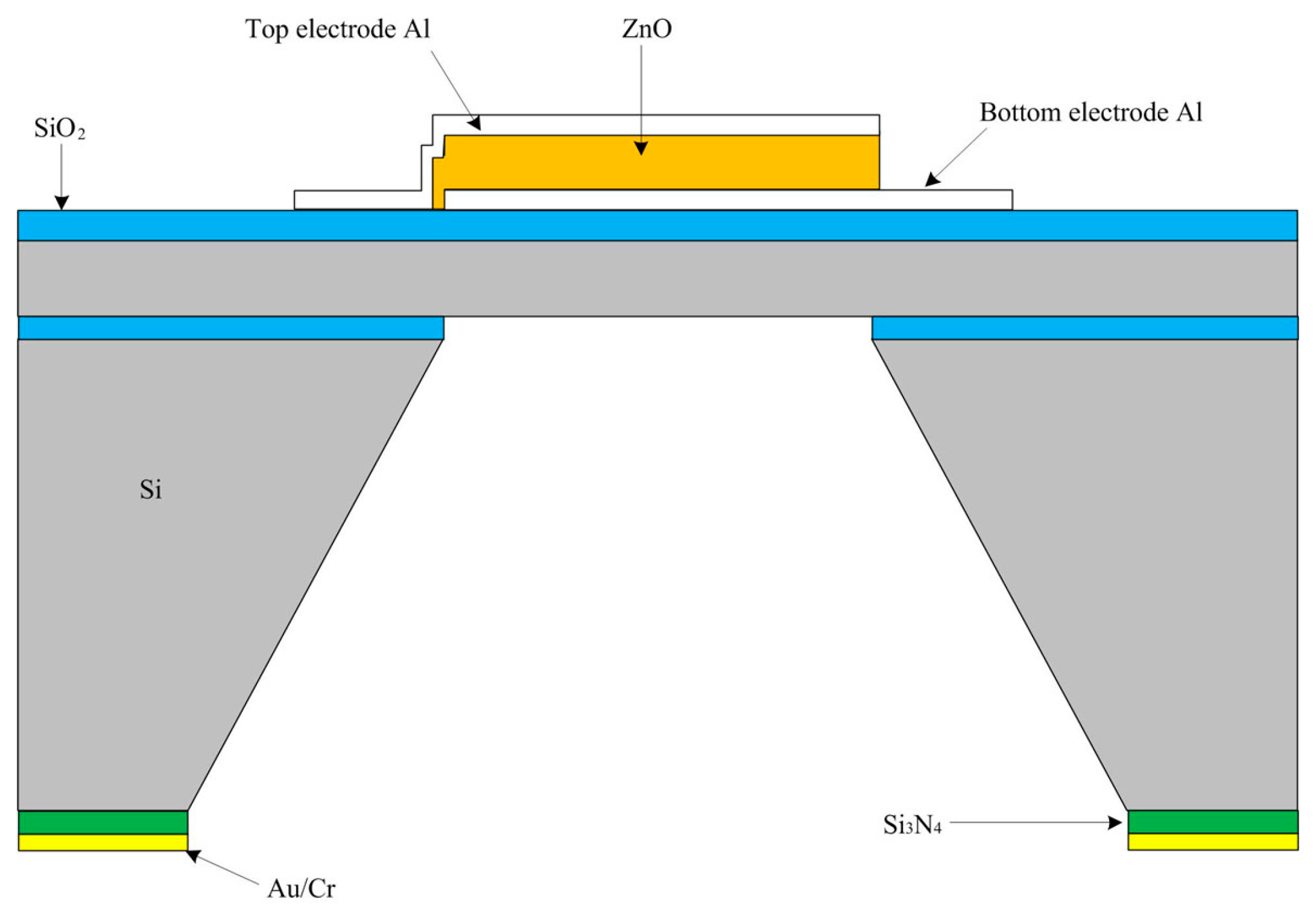
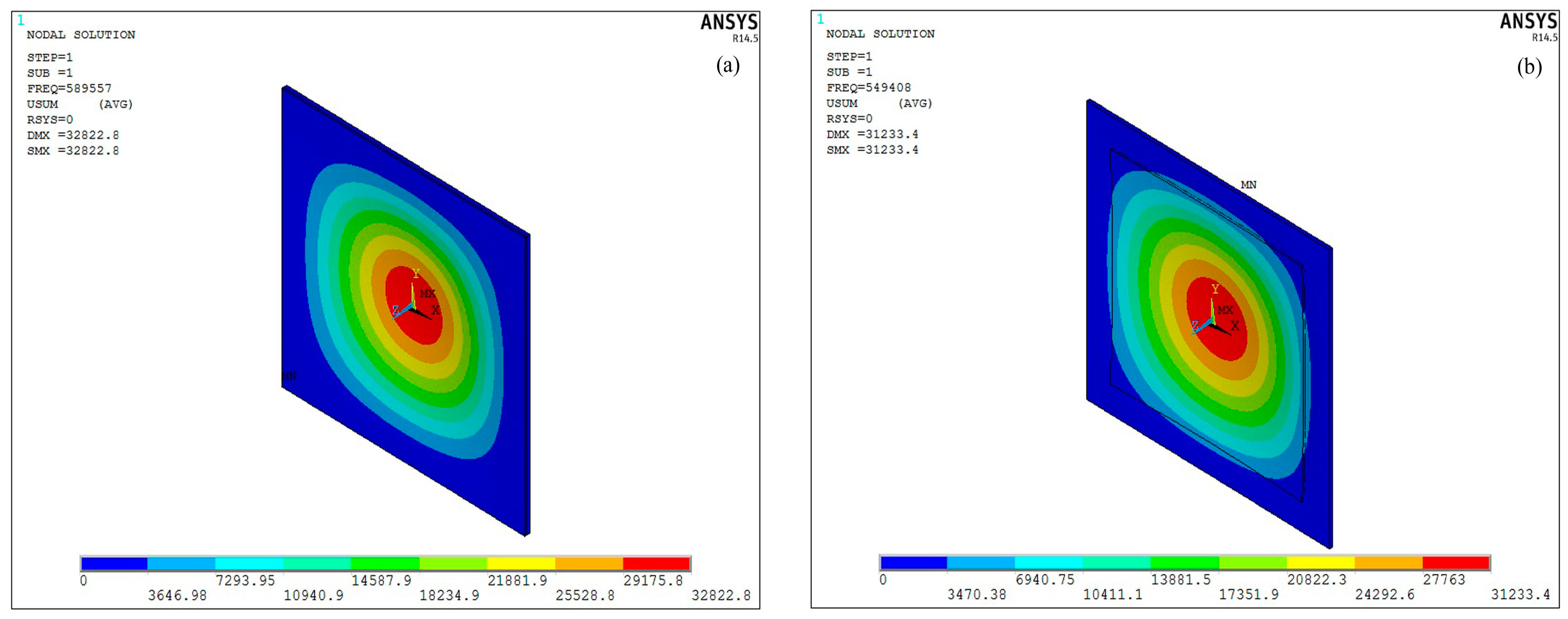
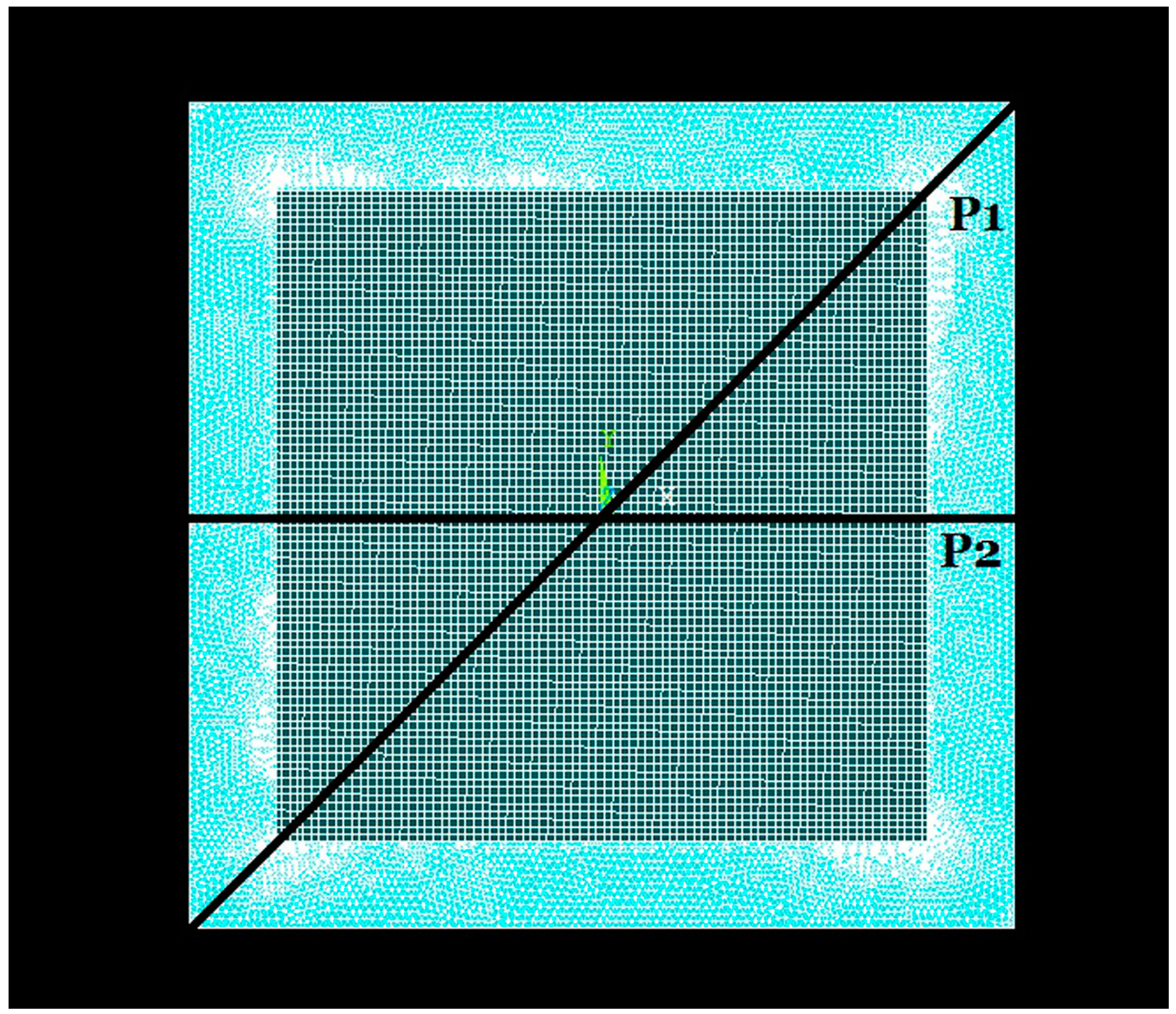
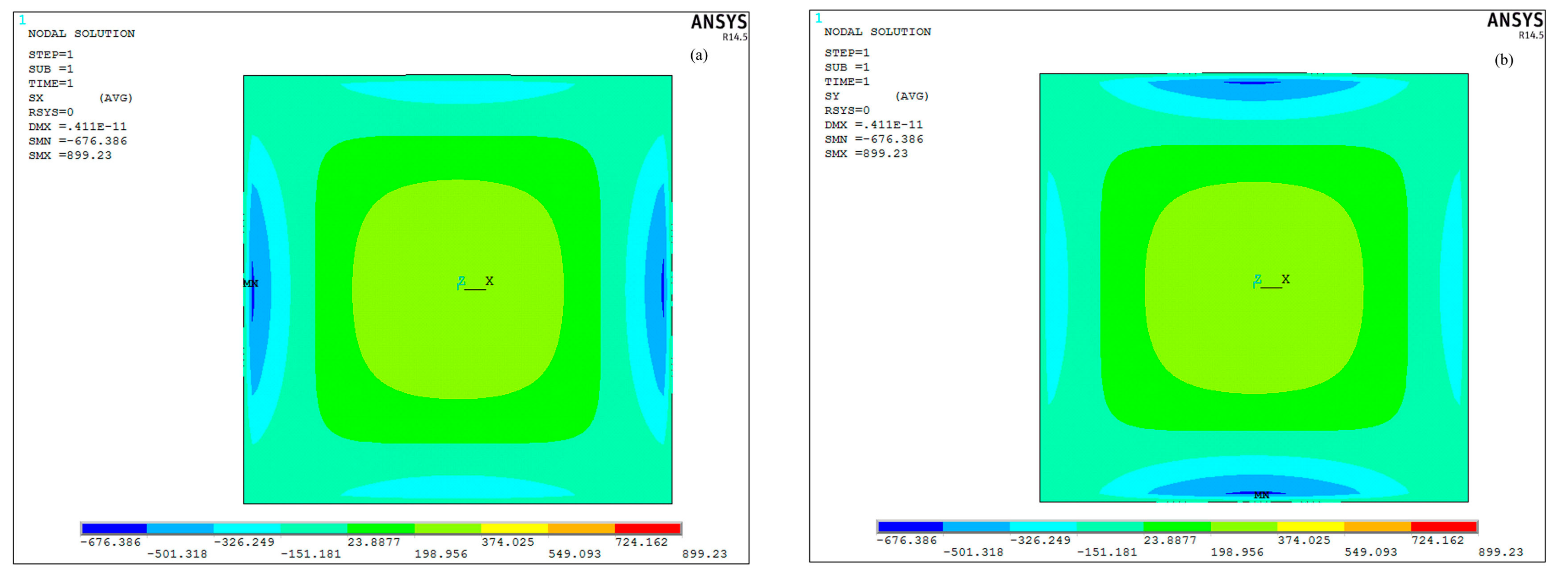
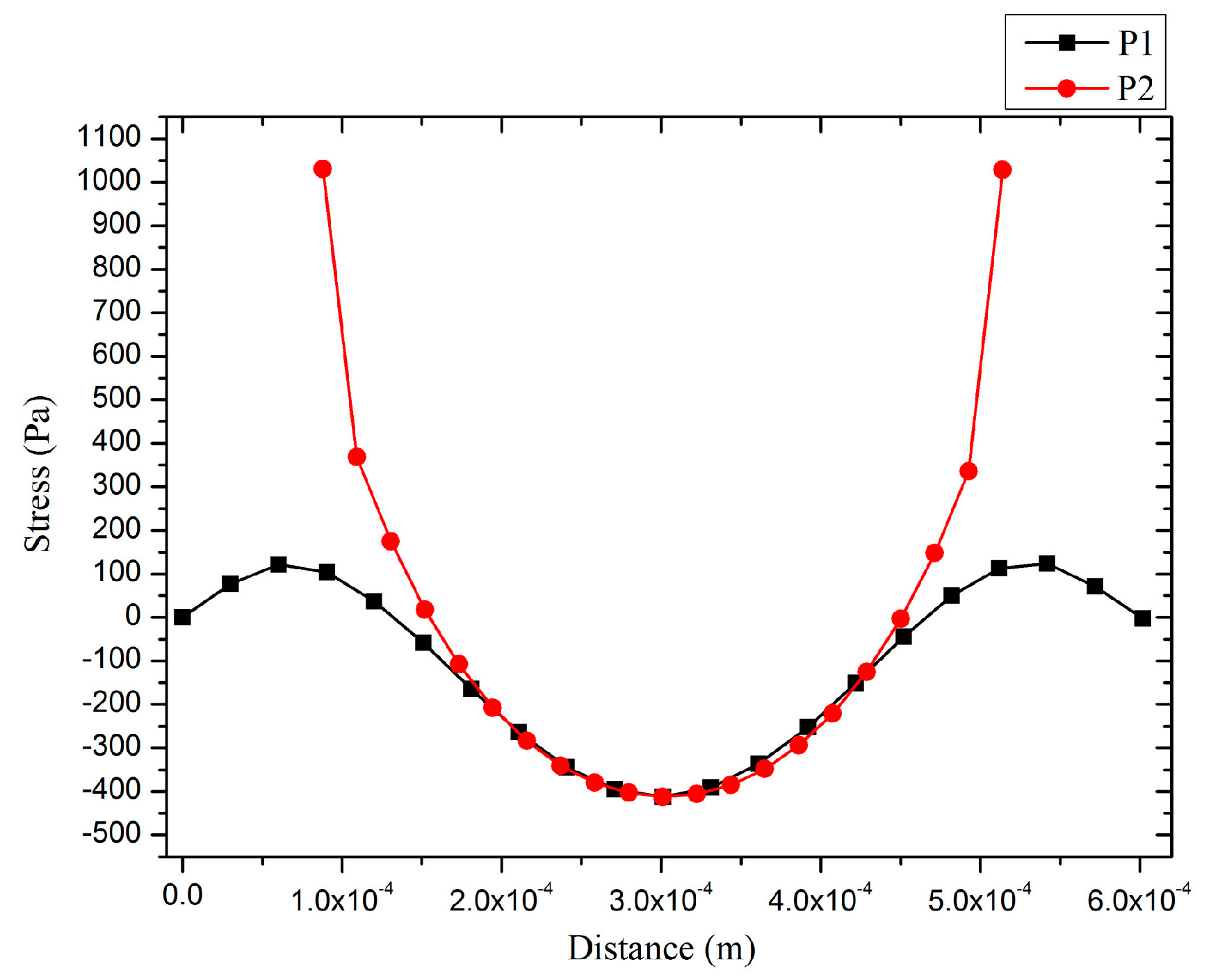
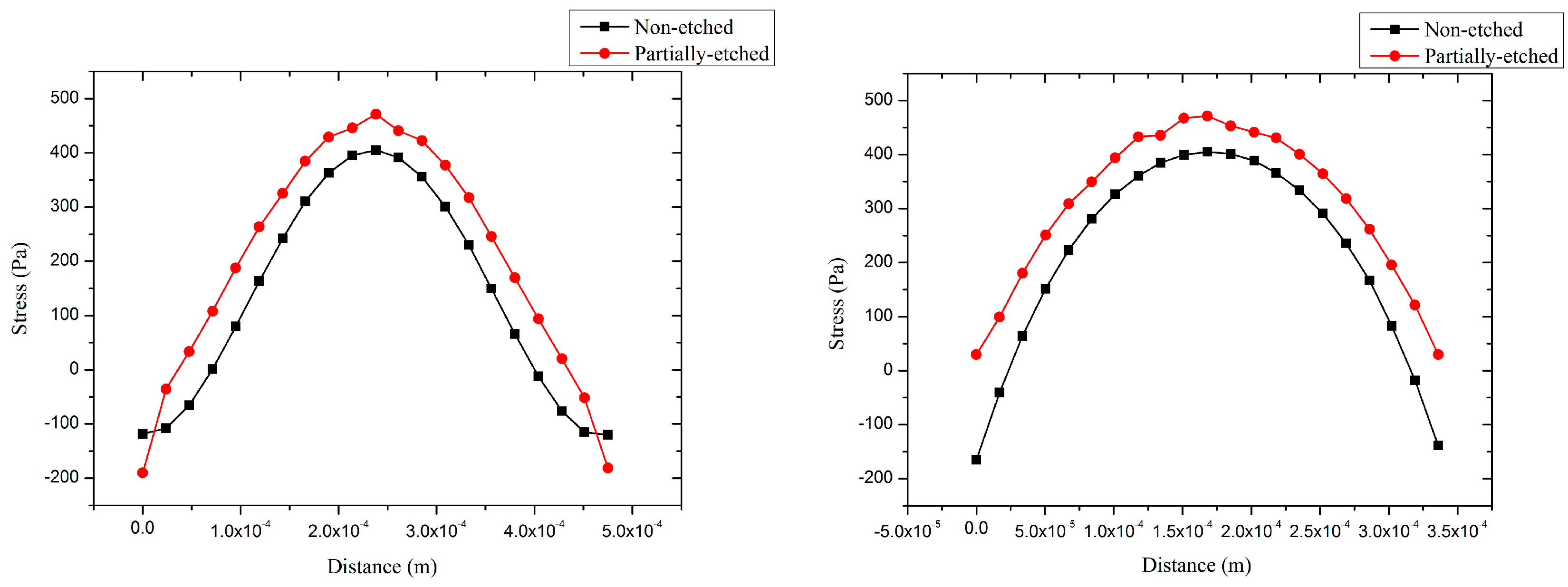
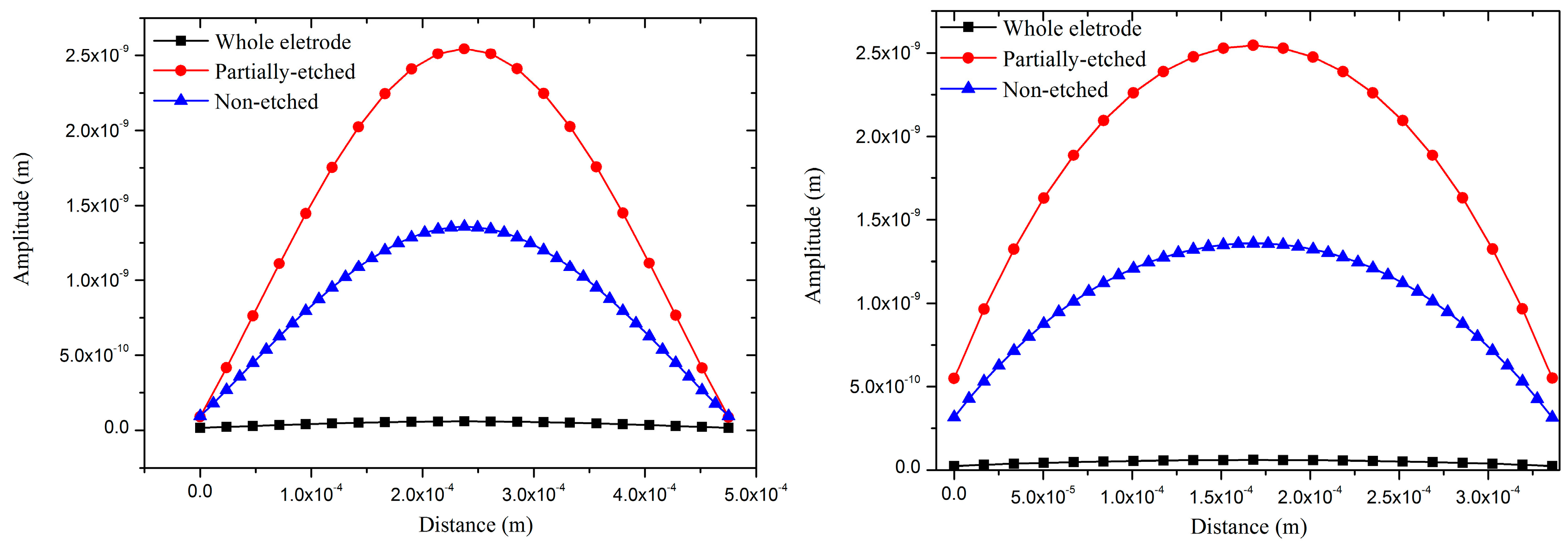

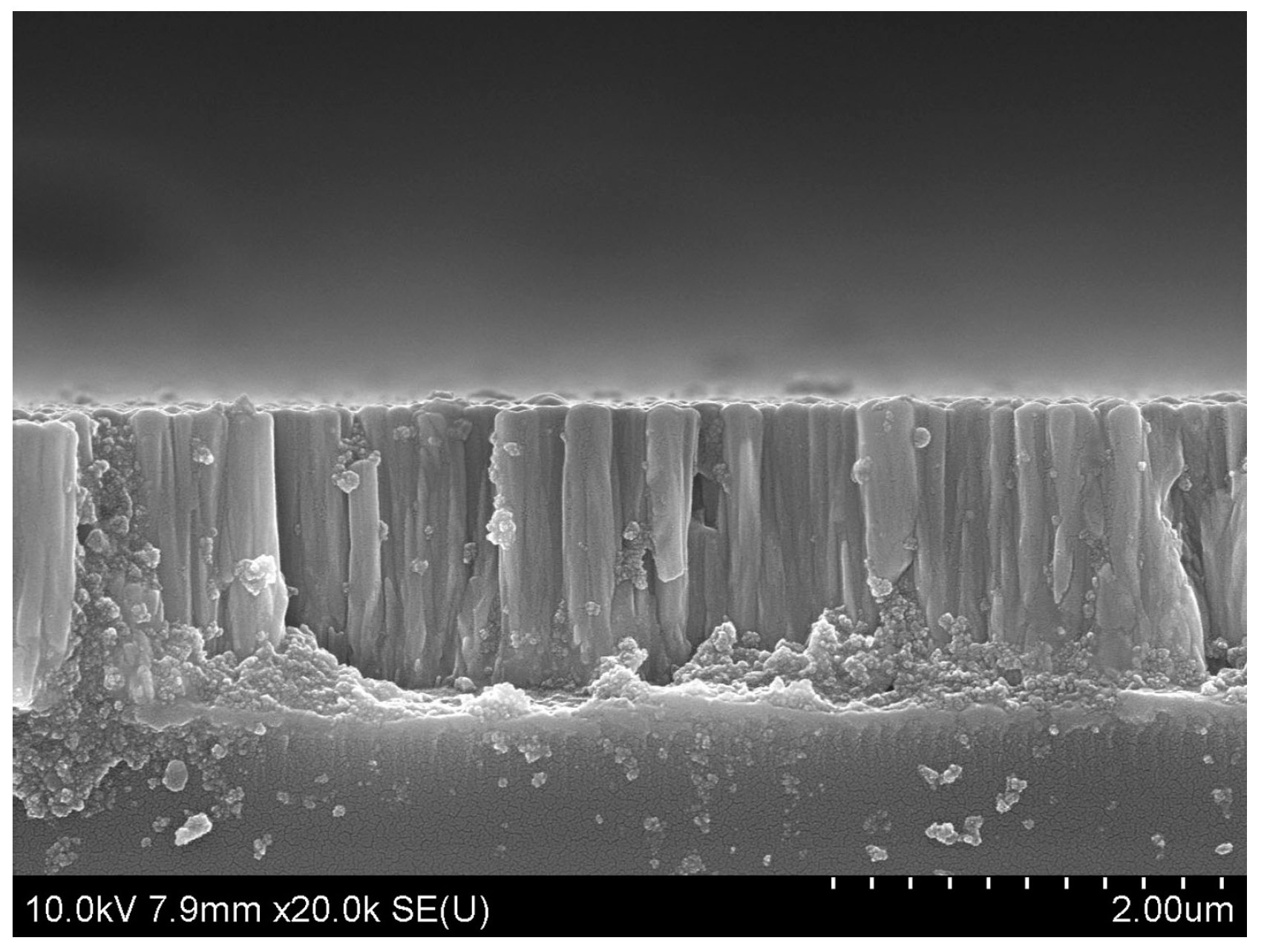

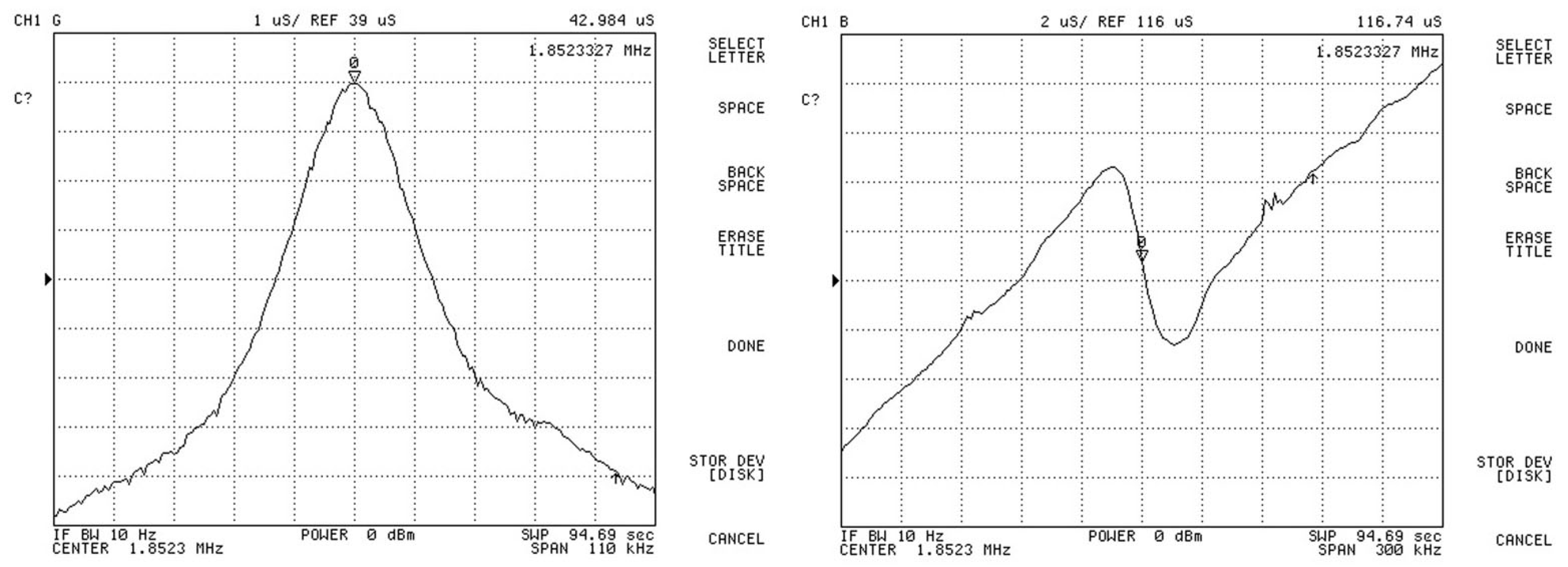

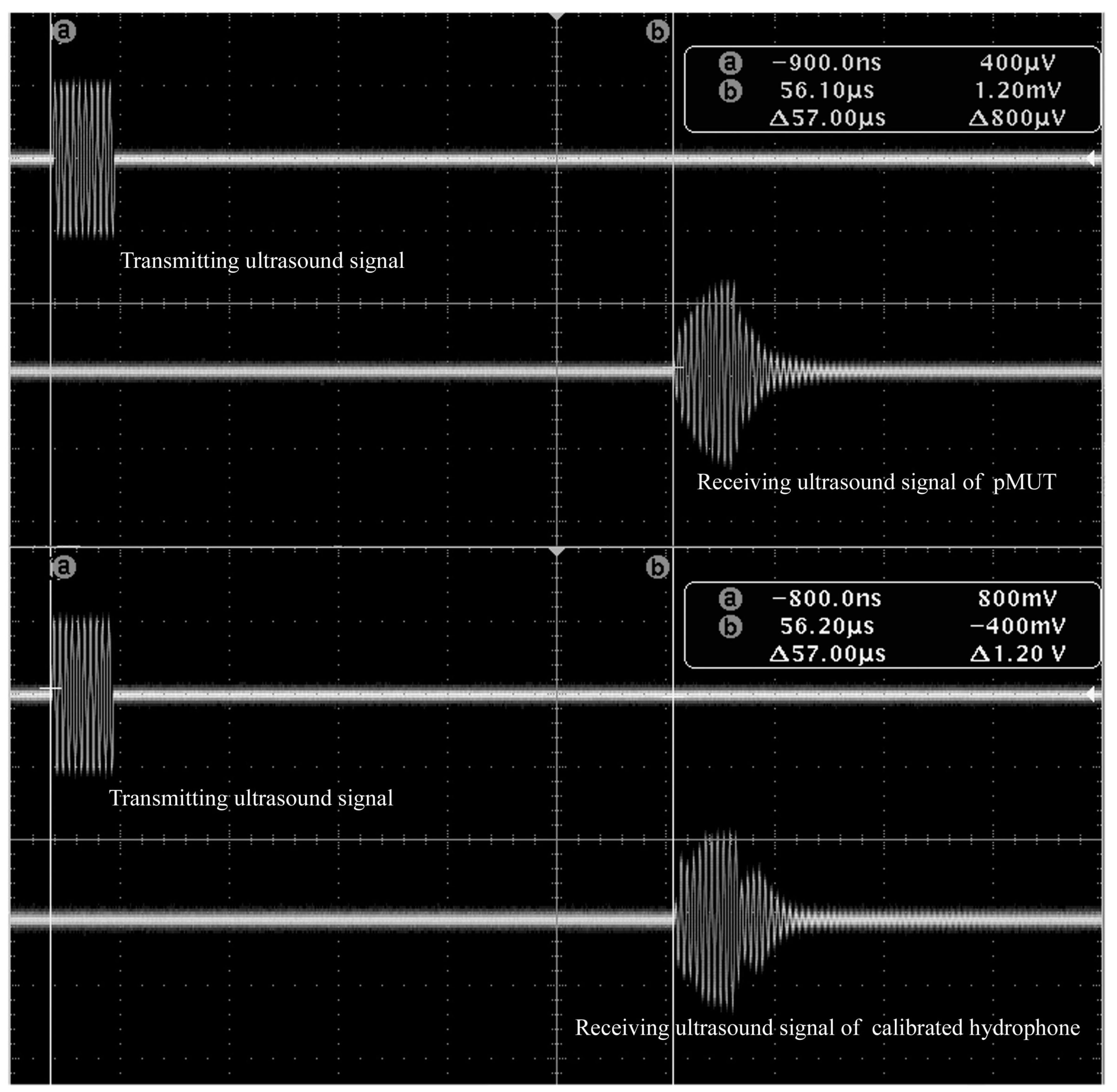
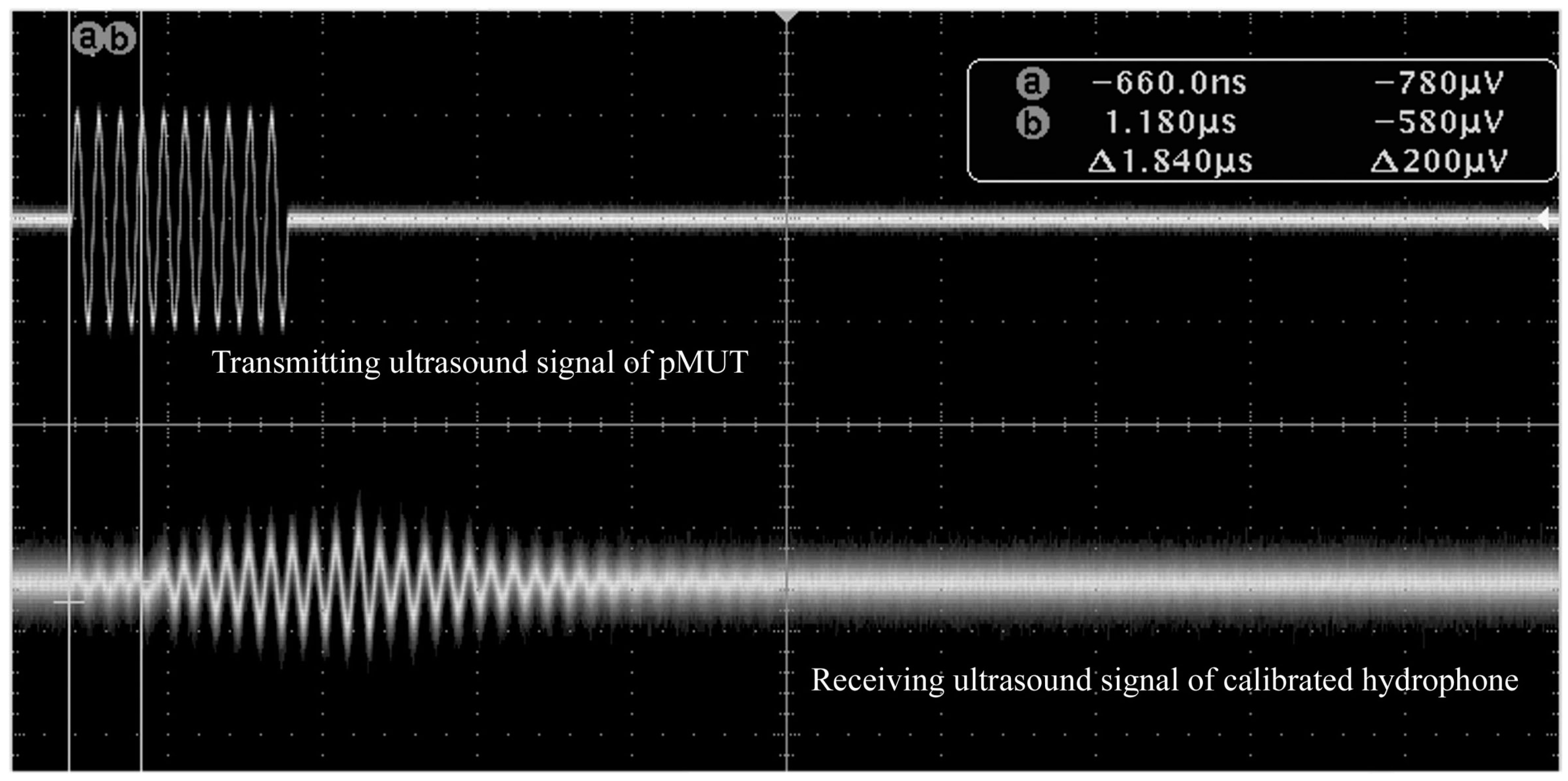
| Materials | Young’s Modulus (GPa) | Density (kg·m−3) | Poisson’s Ratio | Thickness (μm) |
|---|---|---|---|---|
| ZnO | 120 | 5.68 | 0.446 | 3 |
| Si | 167 | 2.33 | 0.28 | 6 |
© 2017 by the authors. Licensee MDPI, Basel, Switzerland. This article is an open access article distributed under the terms and conditions of the Creative Commons Attribution (CC BY) license (http://creativecommons.org/licenses/by/4.0/).
Share and Cite
Li, J.; Ren, W.; Fan, G.; Wang, C. Design and Fabrication of Piezoelectric Micromachined Ultrasound Transducer (pMUT) with Partially-Etched ZnO Film. Sensors 2017, 17, 1381. https://doi.org/10.3390/s17061381
Li J, Ren W, Fan G, Wang C. Design and Fabrication of Piezoelectric Micromachined Ultrasound Transducer (pMUT) with Partially-Etched ZnO Film. Sensors. 2017; 17(6):1381. https://doi.org/10.3390/s17061381
Chicago/Turabian StyleLi, Junhong, Wei Ren, Guoxiang Fan, and Chenghao Wang. 2017. "Design and Fabrication of Piezoelectric Micromachined Ultrasound Transducer (pMUT) with Partially-Etched ZnO Film" Sensors 17, no. 6: 1381. https://doi.org/10.3390/s17061381





